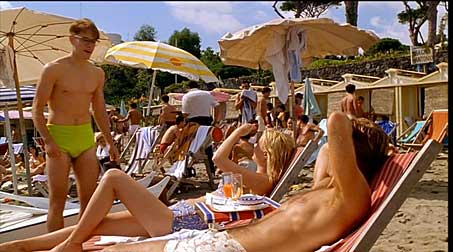|
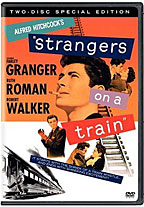
Strangers
On A Train
Warner Brothers,
1951
Director:
Alfred
Hitchcock
Screenplay:
Raymond Chandler
Starring:
Farley Granger, Robert Walker, Ruth Roman, Leo G. Carroll, Patricia Hitchcock
, Laura Elliott, Marion Lorne
Unrated, 101 minutes
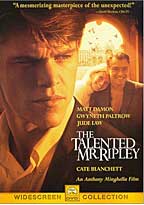
The
Talented Mr. Ripley
Paramount, 1999
Screenplay/Director:
Anthony Minghella
Starring:
Matt Damon, Gwyneth Paltrow, Jude Law, Cate Blanchett, Philip Seymour
Hoffman
Rated R, 138 minutes
|
Male
Bonding
by Michael D. Klemm
Reprinted
from Outcome, August,
2000
It might be awhile
before "Lesbian Mystery Writers 101" is offered at colleges
across America. But if there was such a thing, the late Patricia Highsmith
would no doubt be the featured author. Highsmith is best known for her
series of novels about a charming sociopath named Tom Ripley. While her
novels are not always explicitly gay, the undercurrents are there for
anyone who reads between the lines. This column will examine two major
film adaptations of her work: Alfred Hitchcock's classic Strangers
on a Train (1951) and Anthony Minghella's
The Talented Mr. Ripley (1999).

Strangers
on a Train
is not always mentioned in the same breath as Vertigo, Psycho and
Rear Window, but it is nevertheless one of his ten greatest films.
Adapted from Highsmith's novel by Raymond Chandler,
Strangers on a Train spins the tale of Guy Haines (Farley
Granger) and Bruno Antony (Robert Walker), two men whose lives are changed
forever following a chance meeting on a train. Guy is a well known tennis
pro while Bruno is a spoiled, and mentally unstable, playboy who lives
with his rich parents.
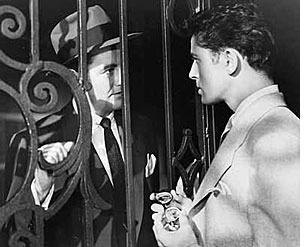 The
two men are polar opposites. Naive but ambitious, Guy is a social climber
with political aims. He is trying to quietly divorce his unfaithful wife
Miriam so that he can marry Anne Morton, a Senator's daughter. Bruno is
wealthy and bored, and lives to create chaos. Recognizing Guy from the
papers, Bruno strikes up a conversation and insists that Guy join him
for lunch in his stateroom. Their talk culminates with Bruno's idea for
a perfect murder: two strangers meet on a train and agree to "swap
murders" so that there is no motive to connect either of them. Bruno
offers to kill Guy's wife if Guy will kill Bruno's father. Guy recognizes
Bruno for the nutcase that he is but makes the mistake of humoring him.
Believing that they have made a pact together, Bruno kills Miriam and
then expects Guy to return the favor. He then stalks Guy, eventually becoming
his worst nightmare. His primary reason for stalking Guy is obvious, but
could there be other dynamics at work here? The
two men are polar opposites. Naive but ambitious, Guy is a social climber
with political aims. He is trying to quietly divorce his unfaithful wife
Miriam so that he can marry Anne Morton, a Senator's daughter. Bruno is
wealthy and bored, and lives to create chaos. Recognizing Guy from the
papers, Bruno strikes up a conversation and insists that Guy join him
for lunch in his stateroom. Their talk culminates with Bruno's idea for
a perfect murder: two strangers meet on a train and agree to "swap
murders" so that there is no motive to connect either of them. Bruno
offers to kill Guy's wife if Guy will kill Bruno's father. Guy recognizes
Bruno for the nutcase that he is but makes the mistake of humoring him.
Believing that they have made a pact together, Bruno kills Miriam and
then expects Guy to return the favor. He then stalks Guy, eventually becoming
his worst nightmare. His primary reason for stalking Guy is obvious, but
could there be other dynamics at work here?
 Because
this was the 1950s, Hitchcock could not state that Bruno was gay. But
even a casual viewing of the film makes one wonder if the censors were
sleeping. Discussing Bruno's homosexuality, latent or otherwise, has to
be done cautiously. Bruno is not a flamer, though he is, in some ways,
almost an Oscar Wilde dandy. He is loud, he is
flamboyant, his tie is embroidered with lobsters. He also lets his daffy
mother give him manicures. Because
this was the 1950s, Hitchcock could not state that Bruno was gay. But
even a casual viewing of the film makes one wonder if the censors were
sleeping. Discussing Bruno's homosexuality, latent or otherwise, has to
be done cautiously. Bruno is not a flamer, though he is, in some ways,
almost an Oscar Wilde dandy. He is loud, he is
flamboyant, his tie is embroidered with lobsters. He also lets his daffy
mother give him manicures.
|
|
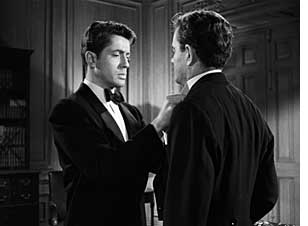 Stereotypical?
In lesser hands it might have been. Walker steals every scene in which
he appears but his performance is subtle and not over-the-top. His attraction
to Guy is presented with delicate nuances.... he makes quiet eye contact
with Guy... he acts like a spurned lover when Guy hangs up the phone on
him. Perhaps the "gayest" moment occurs when Bruno crashes a
party at the Senator's house. When Guy tells him to get out, Bruno looks
hurt and whines "But Guy, I like you." Guy, apparently
experiencing a moment of gay panic, punches Bruno. But then he, almost
lovingly, straightens Bruno's tie before escorting him off the premises. Stereotypical?
In lesser hands it might have been. Walker steals every scene in which
he appears but his performance is subtle and not over-the-top. His attraction
to Guy is presented with delicate nuances.... he makes quiet eye contact
with Guy... he acts like a spurned lover when Guy hangs up the phone on
him. Perhaps the "gayest" moment occurs when Bruno crashes a
party at the Senator's house. When Guy tells him to get out, Bruno looks
hurt and whines "But Guy, I like you." Guy, apparently
experiencing a moment of gay panic, punches Bruno. But then he, almost
lovingly, straightens Bruno's tie before escorting him off the premises.
[Reviewer's note,
2007: There is something else that is interesting about that scene. When
Guy punches Bruno, the audience is treated to a point-of-view shot from
Bruno's perspective as Guy's fist flies straight into the camera.
Hitchcock used such POV shots to create audience identification. Is he
inviting us to identify with the villian? Feel Bruno's hurt as Guy rejects
him? ]
 During
another pivotal scene, Guy embraces the woman he loves, but their kiss
is very stiff. Hitchcock aficionados all agree that the Master choreographed
his kisses very carefully. The kiss in Strangers
on a Train exhibits none of the romance or eroticism
of, say, Cary Grant and Ingrid Bergman's kiss in Notorious or James
Stewart and Grace Kelly's in Rear Window. To be honest, he seems
downright uncomfortable in most of his scenes with Anne. Yet during their
first meeting on the train, Guy seems at times to be entranced by Bruno. During
another pivotal scene, Guy embraces the woman he loves, but their kiss
is very stiff. Hitchcock aficionados all agree that the Master choreographed
his kisses very carefully. The kiss in Strangers
on a Train exhibits none of the romance or eroticism
of, say, Cary Grant and Ingrid Bergman's kiss in Notorious or James
Stewart and Grace Kelly's in Rear Window. To be honest, he seems
downright uncomfortable in most of his scenes with Anne. Yet during their
first meeting on the train, Guy seems at times to be entranced by Bruno.
Problematic for some
gay writers, The Celluloid Closet's Vito Russo for example, is
the fact that Bruno is a Mama's Boy. What Russo didn't realize, however,
is that almost all of Hitchcock's villains have doting or controlling
mothers. He also failed to note that most viewers like Bruno much better
than they do Guy. Forgetting for a moment that he is a killer, Bruno is
one of the most lovable characters in all of Hitchcock's cinema.
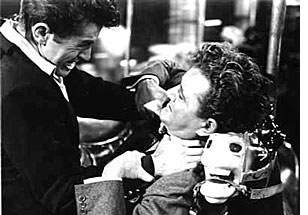 Its
coded homosexuality aside, Strangers on a
Train is an exciting thriller. Like the shower in Psycho
and the chase down Mt. Rushmore in North by Northwest, this film
showcases numerous nail-biting scenes of carefully orchestrated suspense.
From the murder of Guy's wife to a climactic fight onboard a runaway carousel,
Strangers on a Train offers
thrills aplenty. Gallows humor pervades what is, thematically, one of
Hitchcock's darkest films as the director makes profound statements on
the duality of man. Guy, despite his golly-gee persona, is not an innocent
hero with a white hat. It's good to be the king, and Guy cannot fail to
recognize what class privileges his new girl friend offers. The only thing
standing in his way is his wife and Bruno removes her. Bruno is Guy's
dark side; Bruno is the man that Guy wants to be if only he had the cajones
to do the deed himself. In Hitchcock's universe, it is rare that anyone,
including the audience, is completely guiltless. Its
coded homosexuality aside, Strangers on a
Train is an exciting thriller. Like the shower in Psycho
and the chase down Mt. Rushmore in North by Northwest, this film
showcases numerous nail-biting scenes of carefully orchestrated suspense.
From the murder of Guy's wife to a climactic fight onboard a runaway carousel,
Strangers on a Train offers
thrills aplenty. Gallows humor pervades what is, thematically, one of
Hitchcock's darkest films as the director makes profound statements on
the duality of man. Guy, despite his golly-gee persona, is not an innocent
hero with a white hat. It's good to be the king, and Guy cannot fail to
recognize what class privileges his new girl friend offers. The only thing
standing in his way is his wife and Bruno removes her. Bruno is Guy's
dark side; Bruno is the man that Guy wants to be if only he had the cajones
to do the deed himself. In Hitchcock's universe, it is rare that anyone,
including the audience, is completely guiltless.
Fans of the film
might be interested to know that an alternate version (a British preview
print) is now available on video. There is little difference between the
two (the ending punchline was changed) but the initial meeting on the
train is longer... especially the moment when Bruno insists that
Guy join him for lunch in his stateroom. This extended scene makes Bruno's
invitation appear more like a date, and may also explain why it was cut.
|
|
Almost fifty years
later, writer/director Anthony Minghella was able to both include and
magnify Highsmith's queer undercurrents in his film version of
The Talented Mr. Ripley. Matt
Damon stars as Tom Ripley, a devious young man who longs to trade his
rags for riches. He gets his chance when Herbert Greenleaf, a wealthy
shipping magnate, notices the Princeton shield on Ripley's jacket and
asks him if he knew his son, Dickie. Ripley, who never attended Princeton
and had borrowed the jacket from a friend, seizes the moment. Greenleaf
offers to pay Ripley $1,000 to travel to Italy and convince his bohemian,
jazz-loving, son to come home.
 Ripley
travels to Italy where he meets Dickie (Jude Law)
and his girl friend Marge (Gwynneth Paltrow) who spend their days sunbathing
on the beach and sailing. Ripley pretends that they are old college chums
(Dickie of course has no memory of him) and then wins Dickie's
friendship when a pile of jazz records drops from his suitcase. Ripley
is invited to move in with Dickie and eats his food and wears his clothes.
He also begins to display his "talents." such as forging signatures
and imitating voices. Ripley is envious of both Dickie's looks and his
status, and he studies his host very closely. But Ripley is feeling more
than just envy; he is also falling in love with him. Ripley
travels to Italy where he meets Dickie (Jude Law)
and his girl friend Marge (Gwynneth Paltrow) who spend their days sunbathing
on the beach and sailing. Ripley pretends that they are old college chums
(Dickie of course has no memory of him) and then wins Dickie's
friendship when a pile of jazz records drops from his suitcase. Ripley
is invited to move in with Dickie and eats his food and wears his clothes.
He also begins to display his "talents." such as forging signatures
and imitating voices. Ripley is envious of both Dickie's looks and his
status, and he studies his host very closely. But Ripley is feeling more
than just envy; he is also falling in love with him.
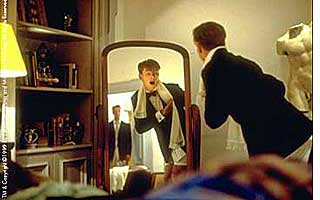 For
the first third of the film, life becomes paradise as Ripley enjoys a
taste of the sweet life while becoming more and more enraptured with Dickie.
Upon discovering that "My Funny Valentine" is Dickie's favorite
song, Ripley sings it to him in a jazz club. His longing is beautifully
conveyed during a scene where the two men play chess while Dickie lounges
in a bathtub. Ripley brazenly admires his friend's body and even playfully
suggests getting into the tub with him. Desires becomes fetish as he sniffs
Dickie's expensive suit while he sleeps on a train. And then everything
changes. Ripley is suddenly tossed aside during a trip to Rome when Dickie's
obnoxious drinking buddy (Philip Seymour Hoffman) arrives. Back home alone,
Ripley dresses up in Dickie's clothes, lip-synchs to a record and dances
in front of a mirror. This he does with all the exuberance of a drag queen
onstage. For
the first third of the film, life becomes paradise as Ripley enjoys a
taste of the sweet life while becoming more and more enraptured with Dickie.
Upon discovering that "My Funny Valentine" is Dickie's favorite
song, Ripley sings it to him in a jazz club. His longing is beautifully
conveyed during a scene where the two men play chess while Dickie lounges
in a bathtub. Ripley brazenly admires his friend's body and even playfully
suggests getting into the tub with him. Desires becomes fetish as he sniffs
Dickie's expensive suit while he sleeps on a train. And then everything
changes. Ripley is suddenly tossed aside during a trip to Rome when Dickie's
obnoxious drinking buddy (Philip Seymour Hoffman) arrives. Back home alone,
Ripley dresses up in Dickie's clothes, lip-synchs to a record and dances
in front of a mirror. This he does with all the exuberance of a drag queen
onstage.
[Reviewer's
note 2007: MAJOR SPOILERS AHEAD. In hindsight, I really shouldn't
have devulged this plot point. If you haven't seen this film - and plan
to - skip this paragraph and the last.]
Dickie finally tires of Ripley and tells him to get lost. The
jealous and scorned Ripley snaps and, in a moment of passion, murders
Dickie. He then coldly forges a number of letters, moves to Rome and assumes
Dickie's identity. If he cannot have Dickie, then he will become
Dickie. The rest of the film chronicles Ripley's exploits while he dodges
both Marge's suspicions and the police's. While this is all handled in
a very stylish manner, the final third lacks the pacing and suspense that
was Hitchcock's forte.
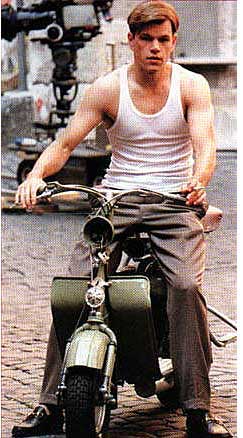 The
decision to cast Matt Damon as Ripley was a masterstroke. Damon looks
like the boy next store and he is utterly convincing whether he is acting
devious or innocent. The audience's sympathies remain with Ripley because
he is presented as a young man who simply wants to better himself. His
character is summed up when he says "I'd rather be a fake somebody
than a real nobody." Because Dickie casts his friends aside at a
whim when he is bored, Ripley's acts are almost condoned. Jude Law plays
Dickie in much the same manner that he played Oscar Wilde's spoiled lover,
Lord Alfred Douglas, in the 1998 Wilde
(not to mention Kevin Spacey's boytoy in Midnight in the Garden
of Good and Evil) and his is the film's standout performance. Gwyneth
Platrow projects a Grace Kelly-like persona to the film, and Cate Blanchett
is also fine as a rich American expatriot who believes that Ripley is
actually Dickie. The Talented Mr. Ripley
is beautifully filmed hybrid of Hitchcock's To Catch A Thief and
Fellini's La Dolce Vita. It is a richly detailed film with fine
character development. As a suspense thriller, however, this film once
again proves that Hitchcock can be imitated but rarely rivaled. The
decision to cast Matt Damon as Ripley was a masterstroke. Damon looks
like the boy next store and he is utterly convincing whether he is acting
devious or innocent. The audience's sympathies remain with Ripley because
he is presented as a young man who simply wants to better himself. His
character is summed up when he says "I'd rather be a fake somebody
than a real nobody." Because Dickie casts his friends aside at a
whim when he is bored, Ripley's acts are almost condoned. Jude Law plays
Dickie in much the same manner that he played Oscar Wilde's spoiled lover,
Lord Alfred Douglas, in the 1998 Wilde
(not to mention Kevin Spacey's boytoy in Midnight in the Garden
of Good and Evil) and his is the film's standout performance. Gwyneth
Platrow projects a Grace Kelly-like persona to the film, and Cate Blanchett
is also fine as a rich American expatriot who believes that Ripley is
actually Dickie. The Talented Mr. Ripley
is beautifully filmed hybrid of Hitchcock's To Catch A Thief and
Fellini's La Dolce Vita. It is a richly detailed film with fine
character development. As a suspense thriller, however, this film once
again proves that Hitchcock can be imitated but rarely rivaled.
The theme that homosexual
repression during the 1950s could lead a gay man to commit murder is handled
without moralizing or resorting to cheap sensation. Any self-loathing
that Ripley feels comes from his lack of status and not from his sexual
desires. The only instance of blind homophobia occurs when a police captain
suggests that Ripley and Dickie were lovers because they are American;
the official hometown view being that "there are no homosexuals in
Italy." A number of gay viewers and reviewers complained loudly because
the film features a gay killer. To them I say: lighten up. We've
spent our lives watching films where straight people commit crimes of
passion, why is it always politically incorrect when the killer is gay?
I found The Talented Mr. Ripley
to be a refreshing change from the usual coming out films, and enjoyed
the fact that the lead character's homosexuality was actually secondary
to the main plot. I will add, however, that I detest the very last scene
of the film.
Reviewer's note 2007:
The Talented Mr. Ripley was also filmed in 1960 - with the homoeroticism
considerably toned down - by Rene Clement as Purple Noon (Plein Soleil).
See
also:
Alfred Hitchcock's Rope
More On Jude Law:
Wilde
|


